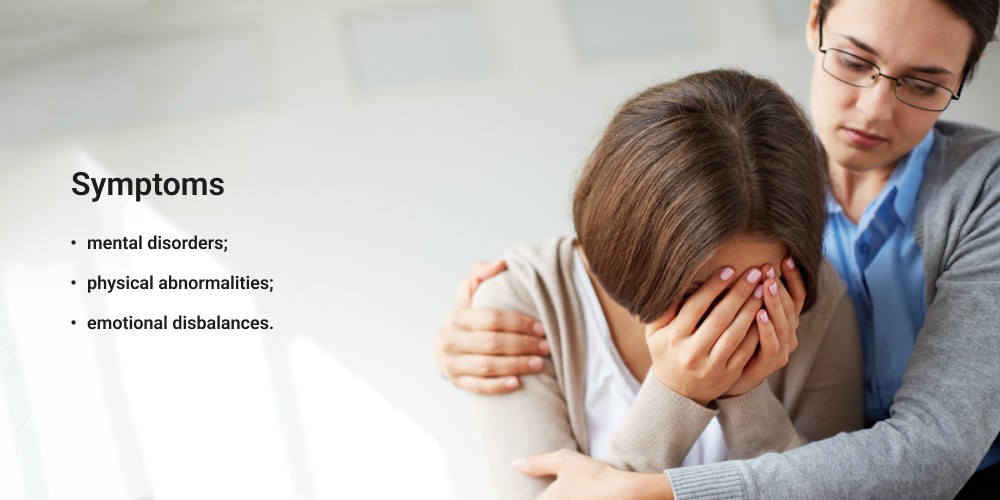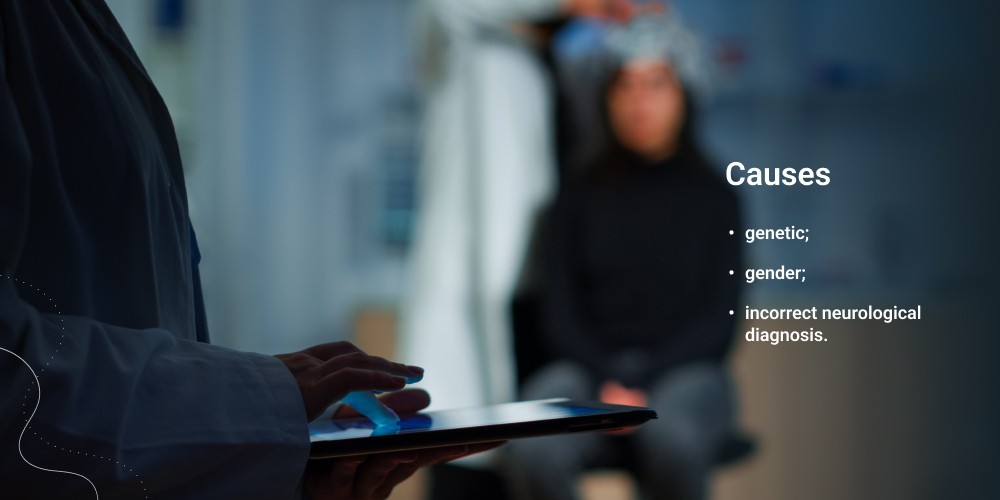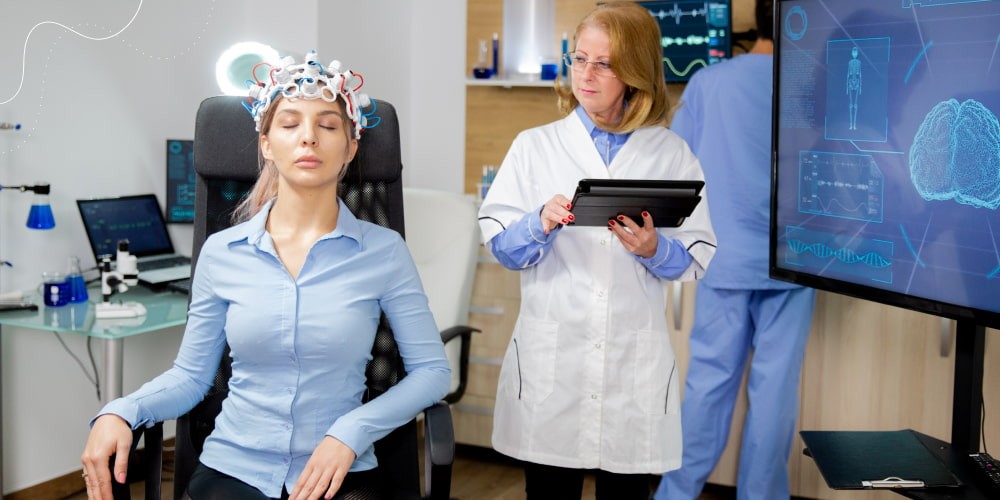Periventricular nodular heterotopia refers to chronic neurological disorders caused by inheritance factors. This disorder is characteristic of impaired nerve cells, dysfunctional to migrate and form naturally proportional dimensions of the gray matter. It starts to develop during the second trimester of fetal development.
According to clinical research, periventricular heterotopia results from gene mutations. In particular, deteriorated FLNA gene responsible for producing protein filamin A provokes fatal consequences for newborns. Baby girls born with heterotopia positive factors more frequently suffer from epileptic seizures and other related neurological disturbances in teenagers and adults. Baby boys represent a risky group if they are diagnosed with heterotopia preconditions when their mothers have serious pregnancy issues. Men with in-birth heterotopia symptoms often face risks of long-life disabilities or fatal consequences of the labor proceedings.
To mitigate the risks of this aggressive neurological disease progression, you need to implement preventive measures, including:
- consulting specialists in case of any related trigger existence;
- following medical prescriptions to treat the evident symptoms;
- adhering to active and healthy lifestyle attributes like physical exercises, work-and-rest schedule, and dietary formula improvements.
Symptoms of Periventricular Heterotopia
Signs of periventricular nodular heterotopia are typical for ailments with a deteriorated neurological system and encompass classified groups:
- mental disorders;
- physical abnormalities;
- emotional disbalances.
However, only qualified neurologists could determine a correct diagnosis upon the proper clinical tests, surveys, and physical examinations. All medical investigation manipulations are directed to learn the following signals of neuronal heterotopia factors:
- Mental disorders. Patients with periventricular heterotopia often refer to epilepsy positive groups due to periodic seizures. In particular, episodes appear upon the diagnosis of drug-resistant epilepsy. However, these convulsive attacks differ from epileptic or other dementia symptoms because of their simple triggers;
- Physical abnormalities. All patients complain of respiratory and cardiovascular dysfunctions, which inexperienced specialists could qualify as stressful situations or anatomical lung and heart problems. Moreover, this heterotopia category is characteristic of head disproportions leading to brain malformations, development delays, and weak immune reactions to infectious diseases;
- Emotional disbalances. Depression and anxiety accompany many neurological ailments, and heterotopia is not an exclusion. Moreover, people living with neuronal heterotopia could feel frustration and emotional restlessness. All emotional factors could signify a more profound neurological disorder and need more professional analysis.
In addition to neurological-related symptoms, you may observe psychosomatic signs like insomnia, headaches, and erectile dysfunctions. The frequency of symptoms could increase during the teenage period, when patients are subject to hormonal changes.
Causes of Periventricular Heterotopia
The main causes of neuronal heterotopia could be grouped into:
- genetic;
- gender;
- incorrect neurological diagnosis.
Neurological-associated cues cause periventricular heterotopia. However, this heterotopia case requires more clinical surveys. You may distinguish several groups of high risky triggers:
- Genetic. The leading factor is particular gene mutations that determine normal brain development. Although people with heterotopia abnormalities do not demonstrate deteriorated intelligence, their physiological and mental parameters identify severe disabilities;
- Gender. Mutations with the X chromosome mean this disorder is equally typical for males and females. However, women do not notice crucial mental changes except involuntary seizures. Men always feel more severe dysfunctions. According to death statistics, males with neuronal heterotopia could face fatal consequences in the labour;
- Incorrect neurological diagnosis. Improper diagnostic and epilepsy-related treatment could provoke respective heterotopia seizures and deteriorate overall health indicators. In particular, convulsive attacks are caused by epilepsy-recommended medication. Some chemical substances could provoke side effects and demonstrate involuntary shaking.
Is Heterotopia a Genetic Disorder?
The periventricular nodular heterotopia has a completely genetic nature. Neurologists still discuss factors that provoke gene mutations and deteriorate gray matter function. Therefore, inheritance-related triggers include the following risky genes:
- FLNA genes. Mutations of this gene imply disabilities of the nerve cells to create standard shapes and motions, leading to brain development delays. The impaired FLNA gene could be hardly renovated without qualified treatment recommendations;
- ARFGEF2 gene. The unnatural changes of this gene provoke neurological disorders of nerve movement instructions. In particular, neurons lose their abilities to control migration processes for comprehensive gray matter development;
- Chromosome 5. The rare cases of chromosome 5 mutations also demonstrate conditions that create a suitable environment for neuronal heterotopia progress.
To reduce the chances of diversified gene mutations, potential patients should plan pregnancy properly and visit neurologists, especially if their family members have been diagnosed with neurological impairments.
Diagnosis of Periventricular Heterotopia
The diagnostic methods allowed for this heterotopia category comprise:
- physical examination;
- blood tests;
- magnetic resonance imaging (MRI);
- PET scan;
- EEG scan;
- ECG diagnostics.
Before neurologists confirm a periventricular heterotopia diagnosis, they conduct several diagnostic methods, including:
- Physical examination. Patients are examined to compare actual physical parameters with regulatory ones. Any omissions or inequalities should signalize neurological or anatomical abnormalities, which could have numerous adverse consequences;
- Blood tests. Neurologists check the blood test fact-findings to exclude other diseases or disorders which could provoke neuron impairments and other dysfunctions of the nerve system. Also, the blood tests discover the patient’s overall health picture and the existence of accompanying ailments;
- Magnetic resonance imaging (MRI). The best diagnostic medium to identify in-birth deterioration in neuron ties. In other words, MRI studies provide a comprehensive picture of seizure-stimulating factors and processes accompanied by involuntary convulsions. In addition, this brain screening method specifies single or multiple nodules of gray matter adjacent to the lateral ventricular walls which become primary signals of periventricular heterotopia;
- PET scan. If a patient’s clinical surveys demonstrate cancer or heart disease risks, neurologists could use PET scanning to exclude all possible cases. The PET scan provides the comprehensive screening of all patient systems and nerves responsible for the essential living functions;
- EEG scan. Due to the EEG technique, neurologists record brain activities and detect calm and active phases related to epilepsy seizures. This method could become an accompanying measure to MRI surveys;
- ECG diagnostics. Along with EEG surveys, ECG results help exclude cardiovascular problems resulting from progressive neuronal heterotopia disturbances or in-birth heart disorders.
Treatment of Periventricular Heterotopia
The relief approaches which eliminate signs of periventricular nodular heterotopia foresee surgery manipulations and suspend the further deterioration processes. The surgical manipulations are safe for patients because they use laser and radio magnetic technologies in order to remove the leisure.
The post-surgical period includes several recovery methods to support normal living functions:
- Medication therapy. Patients could be prescribed to take anti-seizure medications and sedative products, which eliminate anxiety and depression feelings. Also, vitamins like group B and Omega 3s would be valuable to stimulate immune reactions and improve cognitive functions;
- Physical therapy. These methods comprise activities dedicated to strengthening muscle and body constitution in resistance to deterioration progress and actions aimed at overcoming developmental delays. Along with other neurological disorders, yoga and aerobic exercises should be combined with chess classes to provide harmonic physical growth;
- Gastronomic therapy. Special dietary formulas consisting of vegetables, fruits, and berries are recommended for patients with neurological disabilities. Organic lean protein-contained products are also approved for people diagnosed with neuronal heterotopia. To this end, neurologists suggest adjusting meal habits and excluding hazardous foods like gluten, sugar, trans fats, and others;
- Mental health therapy. Meditation practices and psychological training could become a part of the post-surgical treatment complex to rehabilitate social life activities. In addition, patients should learn techniques to get rid of seizures and anxiety states by themselves. Outdoor activities provide maximum positive effects on mental health recovery. Some specialists highlight the incredible results of art therapy in improving cognitive and emotional functions.
Each therapy program built for a particular neurological disorder requires a proper approach and detailed analysis of external and internal factors which stimulate dysfunctions. As periventricular nodular heterotopia refers to in-birth deterioration, you could hardly recover completely. However, the medication methods eliminate the symptoms and support normal living functions. Therefore, success for the relief formula equals in-time and adequate diagnostic mediums.
Regular Neurological Diagnosis Reduce Risks of Fatal Consequences
Any seizure should not be neglected if a patient notices convulsive periodical attacks. Also, the pre-pregnancy period is critical for careful diagnostics and inclusion of all possible risks for babies. Therefore, everyone should call for a qualified neurological consultation to eliminate the chances of any deterioration progress. Our Lone Star Neurology team can investigate the patient’s medical history and determine the correct diagnosis upon cutting-edge professional clinical surveys and tests.
FAQs
-
What is periventricular nodular heterotopia?
Periventricular nodular heterotopia is a neurological disorder affecting the brain’s gray matter and leading to severe neurological dysfunctions. This disease refers to chronic and originates from gene mutations. Moreover, irreversible impairments start during the second trimester and require proper supervision by a qualified specialist.
-
How is periventricular heterotopia treated?
Periventricular heterotopia has only one appropriate way of treatment therapy – surgery. Using lasers and radio magnetic technologies makes this procedure entirely safe for patients. Upon surgical manipulations, patients are recommended to follow rehabilitation therapies acceptable to neurological disorders. Physical exercises, dietary formulas, and mental health improvement methods are must-have activities to strengthen impaired neurological functions.
-
What is an example of heterotopia?
A traditional neuronal heterotopia includes the following symptoms:
– epilepsy-related seizures, which appear in teenagers age;
– respiratory and cardiovascular dysfunctions;
– mental impairments like brain development delays and abnormal physical dimensions of the head.
-
Is periventricular heterotopia an inherited disease?
Clinical research does not provide reasonable explanations about inheritance evidence of periventricular heterotopia: from positive-diagnosed patients to future generations. However, this ailment qualifies as a neurological disorder and, therefore, could provoke bad reactions in anatomical features of neurons.







 (4 votes, average: 4.75 out of 5)
(4 votes, average: 4.75 out of 5)






Please, leave your review
Write a comment: